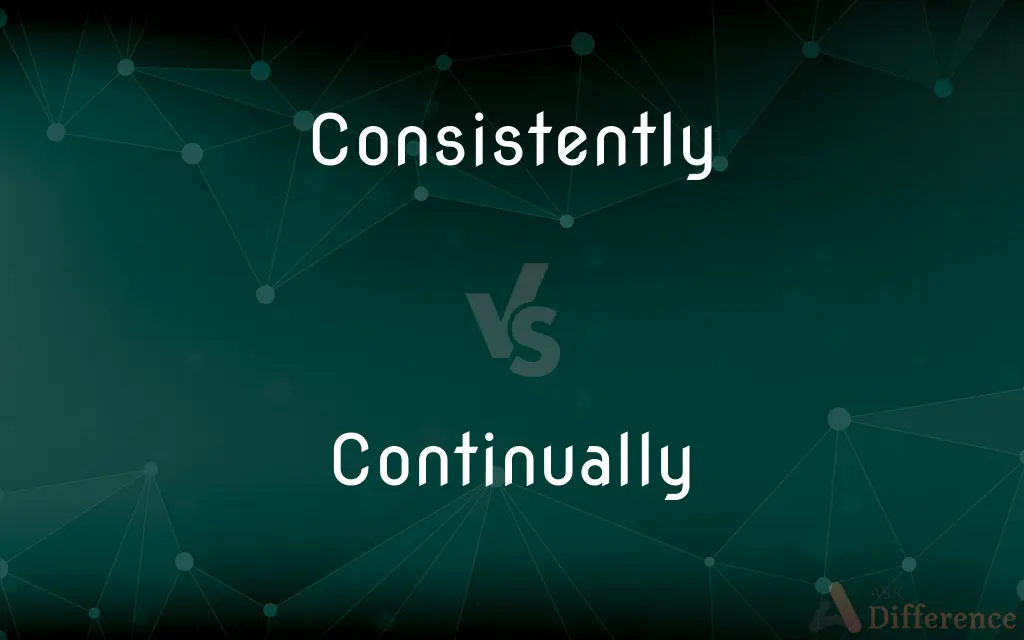Consistently vs. Continually — What's the Difference?
Edited by Tayyaba Rehman — By Maham Liaqat — Updated on March 15, 2024
Consistently refers to uniformity and reliability over time, whereas continually implies ongoing action with possible interruptions.

Difference Between Consistently and Continually
Table of Contents
ADVERTISEMENT
Key Differences
Consistently implies actions or conditions that are uniform and stable over time, suggesting reliability and predictability. For example, a student who consistently earns high grades maintains a certain level of performance across different assessments. On the other hand, continually refers to something that happens repeatedly over a period but may include interruptions or variations. For instance, a clock that chimes continually does so at regular intervals, yet there are pauses between the chimes.
When discussing behavior or performance, being consistent means maintaining a particular standard or approach without significant change. This concept is crucial in contexts where steadiness is valued, such as in work quality or personal habits. Conversely, continual behavior or actions might not have the same level of steadiness but are notable for their persistence over time, often implying a dynamic or repetitive nature.
In terms of application, consistently is often used in settings that value precision, such as in scientific experiments, quality control in manufacturing, or personal discipline in daily routines. It highlights the absence of fluctuation and the presence of control and predictability. Meanwhile, continually is more applicable to scenarios where actions or events recur over time, regardless of regularity, such as in continually reviewing a document for updates or improvements.
The distinction also extends to perceptions and expectations. A consistently positive experience with a brand builds trust and loyalty due to the predictability of satisfaction. In contrast, a service that needs attention continually might not necessarily reflect poorly on its quality but indicates a need for ongoing engagement or maintenance, such as software that continually receives updates to improve performance or add features.
Understanding the difference between these terms helps in setting appropriate expectations and goals. For instance, striving for consistent improvement in personal skills suggests a gradual, steady progress, whereas continually seeking new opportunities indicates an active, ongoing pursuit that might experience ebbs and flows.
ADVERTISEMENT
Comparison Chart
Definition
Uniformity and reliability over time
Ongoing action with possible interruptions
Key Quality
Stability and predictability
Persistence over time with dynamics
Application
Precision in performance, quality control
Recurrent actions or events
Perception
Trust and loyalty due to predictability
Active engagement and maintenance
Goal Orientation
Gradual, steady progress
Active, ongoing pursuit with variability
Compare with Definitions
Consistently
Reliability.
The software operates consistently, without unexpected crashes.
Continually
Ongoing action.
The company continually updates its policies to stay current.
Consistently
Predictability.
The product's quality has remained consistently high over the years.
Continually
Persistence over time.
She works on her project continually, making steady progress.
Consistently
Absence of fluctuation.
His mood has been consistently positive this week.
Continually
Repetitive occurrence.
The teacher continually revisits the topic to ensure understanding.
Consistently
Uniformity over time.
The athlete trained consistently, showing steady improvement.
Continually
Dynamic nature.
The weather has been changing continually throughout the day.
Consistently
Steady performance.
She consistently receives accolades for her constant high-quality work.
Continually
Possible interruptions.
He is continually interrupted by phone calls throughout the day.
Consistently
In agreement; compatible
The testimony was consistent with the known facts.
Continually
Repeated frequently in the same way; regularly
This information is continually updated
Consistently
Being in agreement with itself; coherent and uniform
A consistent pattern of behavior.
Continually
Without interruption; constantly
I was continually moving around
Consistently
Reliable; steady
Demonstrated a consistent ability to impress the critics.
Continually
Recurring regularly or frequently
Continual improvements in technology.
Consistently
(Mathematics) Having at least one common solution, as of two or more equations or inequalities.
Continually
Not interrupted; steady
A process that requires continual monitoring.
Consistently
Holding true as a group; not contradictory
A consistent set of statements.
Continually
In a continual manner; non-stop.
Consistently
(manner) In a consistent manner.
Continually
In regular or repeated succession; very often.
Consistently
(frequency) constantly; always.
Continually
Without cessation; unceasingly; continuously; as, the current flows continually.
Why do not all animals continually increase in bigness?
Consistently
In a consistent manner.
Continually
In regular or repeated succession; very often.
Thou shalt eat bread at my table continually.
Consistently
In a systematic or consistent manner;
They systematically excluded women
Continually
Seemingly without interruption;
Complained continually that there wasn't enough money
Common Curiosities
Is consistency or continuity more important in work performance?
It depends on the context; consistency is vital for quality and reliability, while continuity is crucial for tasks requiring persistent effort.
What is the main difference between consistently and continually?
Consistently emphasizes uniformity and reliability, while continually indicates ongoing actions with possible pauses or changes.
Why might a process need to be continual?
Processes that involve growth, development, or frequent updates may need to be continual to adapt to new information or improvements.
How can one achieve consistency in personal habits?
By establishing routines and standards that minimize fluctuations and maintaining discipline to adhere to these standards.
What are examples of continual actions?
Continual actions include regular exercise with rest days, ongoing learning with breaks, and periodic maintenance tasks.
Can something be both consistent and continual?
Yes, an action can be both if it repeatedly occurs at regular intervals without significant variation in quality or performance.
How can a business demonstrate consistency?
By delivering products or services that meet established quality standards reliably over time.
Does continual imply a lack of control?
Not necessarily; it suggests a dynamic or evolving nature rather than a lack of control or predictability.
How do continual changes impact a project?
They can introduce flexibility and adaptability, but may also require more management to maintain focus and direction.
How does consistently affect customer perception?
Consistent quality or service builds customer trust and loyalty due to the predictability of satisfaction.
What role does consistency play in personal relationships?
Consistency in behavior and communication fosters trust and understanding in personal relationships.
What might be a reason for continual interruptions?
Environmental factors, the nature of the task, or external demands can lead to continual interruptions in an activity.
Is it better to be consistent or continual in learning?
A combination of both, consistently applying oneself to learning while continually seeking new knowledge or skills, is often most effective.
Can continual improvements lead to consistency?
Yes, continual improvements in processes or skills can eventually lead to a higher level of consistency.
Why might a software need to update continually?
To address security vulnerabilities, improve functionality, or add new features to meet user needs.
Share Your Discovery

Previous Comparison
Shaven vs. Shoven
Next Comparison
Brotherhood vs. SisterhoodAuthor Spotlight
Written by
Maham LiaqatEdited by
Tayyaba RehmanTayyaba Rehman is a distinguished writer, currently serving as a primary contributor to askdifference.com. As a researcher in semantics and etymology, Tayyaba's passion for the complexity of languages and their distinctions has found a perfect home on the platform. Tayyaba delves into the intricacies of language, distinguishing between commonly confused words and phrases, thereby providing clarity for readers worldwide.















































